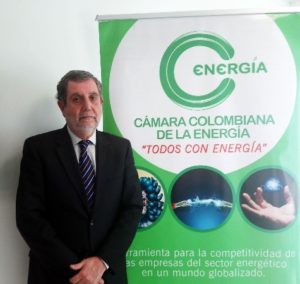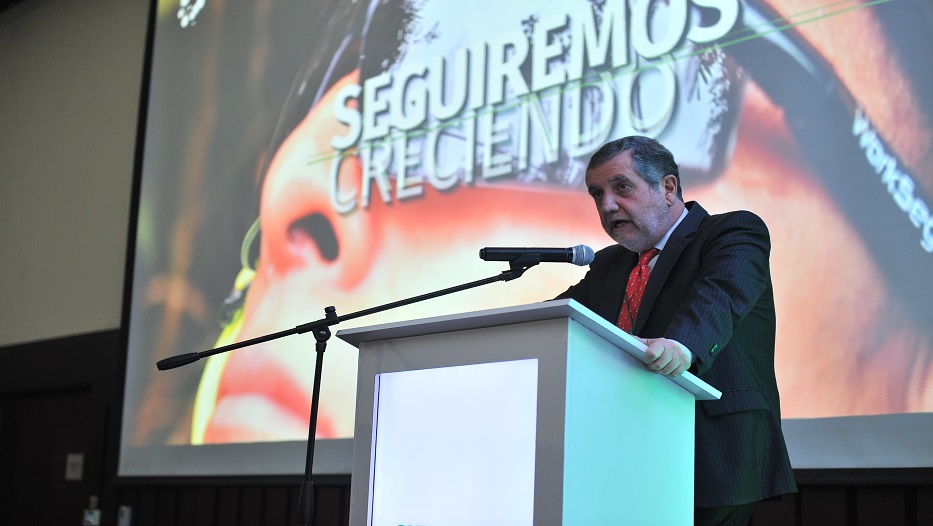admin | 05/02/2021
Colombia’s energy matrix has developed extensively over the last few years, driven by a paradigm shift in operator profiles and defined by Latin America’s current energy transition. Dr. Carlos Zarruk, chairman of the Colombian Energy Chamber (CCEnergía), outlines the region’s roadmap as well as the impact of the health crisis and economic fallout caused by the coronavirus pandemic.
Tell us about the Colombian Energy Chamber and its actions and main goals.
The Colombian Energy Chamber is a guild founded seven and a half years ago. It was established in 2013 and includes companies that manufacture goods and provide services within the power generation and energy industry. We have three groups of companies: electrical materials manufacturers (like Siemens, ABB, Legrand, etc.); engineering firms that provide services, carry out land operations, and contract with power generators (like CAM, some in the ENGIE Group, and JE Jaimes); and a third group of engineering firms with no land operations that structure projects or do conformity assessments (like GERS and CIDET). There are a total of 52 member companies with the fundamental aim of working for competitiveness and developing the Chamber and the companies within the sector. To achieve this goal, we represent the companies in the various public spaces connected to corporate competitiveness.
To get the ball rolling, could you provide a brief description of the current composition of the Colombian energy matrix?
Colombia has seen good, reliable development of its energy matrix. There was a breaking point in the 1990s, and it faced difficulties for four years. In 1994, two laws were issued (192 and 193) allowing private operators into an industry that up until that point was almost exclusively managed by public operators, companies, and institutions. That led to what we have today: between 65% and 70% of power generation and energy distribution is provided by private generation and transmission operators.
The Colombian energy matrix has evolved extensively in terms of provision, service security, and quality, although some challenges still remain. We are currently making strides toward another milestone: renewable energy. We are particularly focused on hydropower. Colombia is a country with about 17,600 megawatts of installed power generation capacity, and of that about 70% comes from water, making it a highly significant resource. Being so focused on water resources may cause some uncertainty due to periods of drought or phenomena like el Niño, so it is important to diversify the matrix, principally with sun and wind.
There is also another challenge in terms of coverage area, as we need to reach areas that are not interconnected (essentially the Amazon rainforest and eastern plains).
What is the Colombian energy industry’s position in LATAM and internationally?
A recent World Economic Forum report stated that, with everything that’s happened, Colombia has risen nine places on the Energy Transition Index (going from 34 to 25 among 315 countries) and is the number two country in Latin America after Uruguay (number 11). We are ahead of countries including Chile and Costa Rica, which are also strong in this regard. We have a powerful, well-structured electricity and energy sector that works well. The sector has five main players:
- Ministry of Mines and Energy, which focuses on sector development policies.
- UPME (Mining and Energy Planning Unit), responsible for making development projections of what the sector should look like. It is making projections up to 50 years in advance in various lines of operation and has shown great prediction capabilities.
- Energy and Gas Regulation Commission, highly structured commission of major independent technical experts.
- National Operation System, operator and coordinator of all industry actions.
- Superintendency of Public Utilities, which provides strict and necessary oversight, because these services are essential for the economy and society at large and need to be guaranteed.
As you mentioned earlier, Colombia has taken notable steps in the energy transition to renewables. Where is it on the roadmap?
In 2014, a law was passed to support the development of non-conventional energy sources, creating tax incentives for companies that work on projects in this field. These incentives were: any materials used are exempt from sales tax; no tariffs on imported products; projects have accelerated depreciation for the first five years; and up to 50% of the project is tax deductible (initially for five years, recently extended to 15). The purpose of these incentives was to stimulate the development of new projects. Nevertheless, this is a slow process, so we are still at the starting line in terms of actually transitioning to renewables.
While no huge advances were seen between 2014 and 2019, this year the government did take significant action, and a number of projects were awarded in two calls to tender. These projects will lead installed capacity from non-conventional sources to rise to nearly 12% by 2022. Looking a few years beyond that (2023-2024), that capacity may reach 25%. Then we will be able to say that we are steadily heading down the path toward renewable energy.
Given our geography, we have great capacity for wind power. There are regions, like the Guajira peninsula, where wind speeds are almost double the global average.
Given our geography, we have great capacity for wind power. There are regions, like the Guajira peninsula, where wind speeds are almost double the global average.
We’ve discussed the most promising renewable energy sources. Could you talk about the ones with the most room for development and the biggest investments?
Colombia’s geography is challenging. On the one hand, it creates areas that are not interconnected or where national transmission is in the Amazon rainforest. However, it does offer great benefits. The entire Los Llanos region and a good deal of the Andean region have a wealth of solar power with great sunlight (6-8 hours per day). As I mentioned, we also have great wind capacity in the east.
The crisis caused by the pandemic has hit all sectors of the economy to a greater or lesser extent. How has the Colombian energy industry been affected?
Both the energy industry and the electricity industry are in a fortunate position because they provide an essential public service both for society at large and manufacturing. Regardless of what’s happening in the world, countries need to do whatever they can to provide uninterrupted service. That’s why, even though most companies were affected, this industry was less hard hit than most sectors. There were cases of slips, because both industrial and commercial demand fell, but it is already bouncing back.
In your opinion what is the biggest challenge that energy companies face to recover in the current scenario?
I think that we need to continue the diversification process and growing renewable energy and energy transition projects. The issue of connecting small projects to the grid also needs to be resolved. When a large power generation company develops a project with all of its technological, financial, and operational capacity, it does everything needed to connect it to the grid. But when a large number of small projects need to be connected, there is a need for clear regulations that all small power generating companies must comply with. That is a challenge. These projects are already beginning to be connected in distributed generation in a large part of the country.
They also need to be made more efficient so that both consumption and generation are impacted.
What role does technology play in the development of the energy sector? What are the future trends in this regard?
Technology is a fundamental factor in the development of the energy transition, which began as a political and environmental issue, but soon became a technological issue. Cost reduction, digitization, big data, etc. are aspects that made the energy transition an unstoppable event. In Colombia, we are especially involved in the process of implementing a standard allowing smart measurement so that 75% of meters are smart meters by 2030. What does this entail? Empowering demand and giving consumers a lot of information on their consumption, schedules, costs, etc. and thus changing usage.
How well do you think energy companies reacted to manage risks and activate contingency plans when the crisis began?
Given its characteristics, this is a sector that prioritizes safety, both in terms of resources and in terms of the impact on its production business. The industry has always operated with stringent safety protocols, which is why it was able to quickly adapt to the conditions created by COVID-19.
What has the insurance industry in Colombia contributed to the development of the energy industry?
The insurance industry is essential in our projects. Developing energy with highly complex long and medium-term projects inherently involves a great deal of uncertainty, because these projects contain a critical technological component with economic, social, and environmental impacts. As well as potential price variation. That’s why the participation of the insurance industry is imperative, as it helps us navigate that uncertainty and supports the energy industry’s development.
“The participation of the insurance industry is imperative, as it helps us navigate that uncertainty and supports the energy industry’s development.”
Finally, as the chairman of the Colombian Energy Chamber, what do you believe are the most important lessons the sector has learned from this crisis?
The lessons learned by the industry were also learned by other sectors, the world, and individuals. Business, life, and interactions are all going to be different from here on out. The world has changed. We’ve learned that the Internet has carved out a fundamental space in interpersonal and business relationships and that digitization has become the reality in all sectors, from financial transactions to industry conferences. A number of online platforms have grown and will alter the dynamics of business. Significantly high numbers of meetings will be held online, and business will stop being done in offices, which will be replaced by telecommuting. What we’ve learned, or need to assimilate, is that we need to leverage this unstoppable trend to the benefit of the enterprise, business, and people.
Colombia has a great energy industry with consistent, regulated, and well-planned development. In 30 years, we have seen a shift in operators, but we still have a significant challenge ahead of us and a great deal of space to electrify. The country consumes 1,500 kW hours per capita per year, while in developed countries this figure is 15,000 kW, so we have huge potential for growth. Our goal is to continue strengthening the sector to reach the forefront of provision of services, both socially and economically, to then participate in the productive and monetary development of the region.

Dr. Zarruk holds a degree in economics and law from the University of Los Andes and a specialization certificate in finance and commercial law from the same university. He has experience in strategic business management in the finance and manufacturing sectors as well as experience leading executive teams. In the public sector he has led support for the transformation and enhancement of small business competitiveness with different Ministry of Commerce, Industry, and Tourism programs aimed at supporting the development of these companies.
Highlights from his career include positions such as general manager of CAM Colombia; deputy minister of Corporate Development at the Ministry of Commerce, Industry, and Tourism; vice chairman of aid at the Central Mortgage Bank; and vice chairman of finance at Corpavi, among others.





